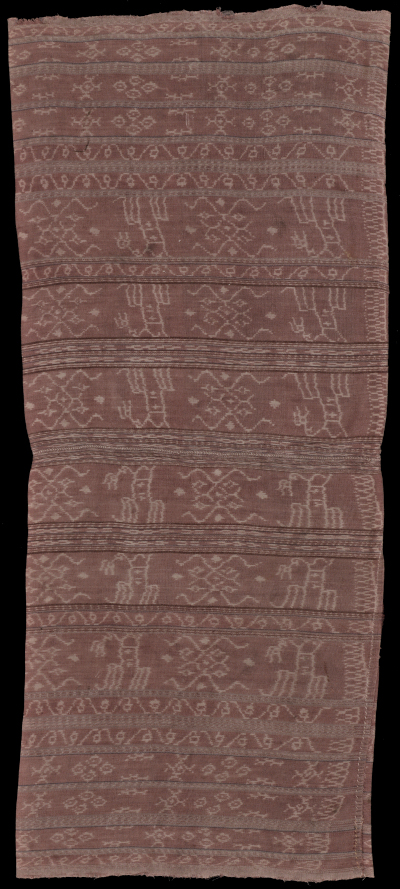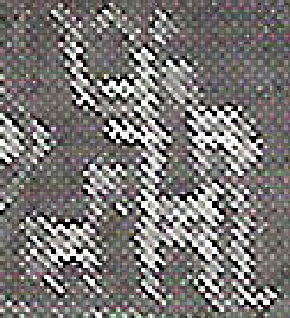| |
 
 | | | |
164 Flores Group, Ngadha
Utang (sarong)  
| | Locale: | Ngadha, probably, Ende being another possibility. Yet another possible locale is northern Lio region called Detusoko. | | Period: | Early 20th c. | | Yarn: | Cotton, hand-spun, fine | | Technique: | Weft ikat | | Panels: | 2 | | Size: | 58.5 x 133 cm (1' 11" x 4' 4") LW: 2.27 | | Weight: | 465 g (16.4 oz), 299 g/m2 (0.98 oz/ft2) | | Design: | Sarong, utang merah, decorated in white on morinda (kombu) with stick figures that most likely represent horses: two facing each other, with a third, much smaller one, hovering above. Horses in this region are shown in profile, with only the legs on the near side showing (hiding from view those on the far side) and with a long tail, often reaching the ground and then curving upward. An alternative reading (triggered by absence of curve on tail on one of each pair of 'horses') is that the motif imitates the caparisoned elephants seen on old patola. The other promiment motifs resemble the embroidery with sewn on beads added to lawo butu, ceremonial sarongs from Ngada, a little to the west. | | Comment: | The stick figures are compatible with both Ngadha and Ende and Ngadha provenance. According to Hamilton, the Ngadha never mastered morinda dye preparation, which may explain the weak tonality. May have been dyed (partly) with mud, or with kayu sepa (kayu sepang, probably sappan) reported to be used in the region. It shows signs of intensive use over a protracted period. While clearly not the work of a master weaver, the piece is interesting on account of its unschooled attempts at figuration. It was most likely made in a remote village, with few examples of more sophisticated weaving to go by. While the smooth feel of the cloth suggests commercial cotton, microscopy shows it to have been made with hand spun. Some soiling, a few small spots of fraying on selvedges, otherwise in good condition. | | Background: | Chapters on Flores Group and Ngadha. | | Published: | Ikat Textiles of the Indonesian Archipelago, 2018.
| | Sources: | The zoomorphic motifs are similar to those on old Ende sarong in Khan Majlis, Indonesische Textilien, Wege zu Goettern und Ahnen, Fig. 366, which appear to represent three horses: a larger one facing a smaller one with shorter tail, and a hovering third. See detail below - magnified from tiny section of printed photo. Other motifs resemble those on some Sikka sarongs, like the utang mitang depicted in Hamilton, Gift of the Cotton Maiden, Fig. 7-11. Ex David E. Bulgin collection. Overall similarity to sarong in Fowler Museum of Cultural History, Nr. UCLA FMCH X88.1284, with caption by Roy Hamilton, though this piece has a more banded structure, without separate midfield.
 | | |

©Peter ten Hoopen, 2025
All rights reserved.
|
|


